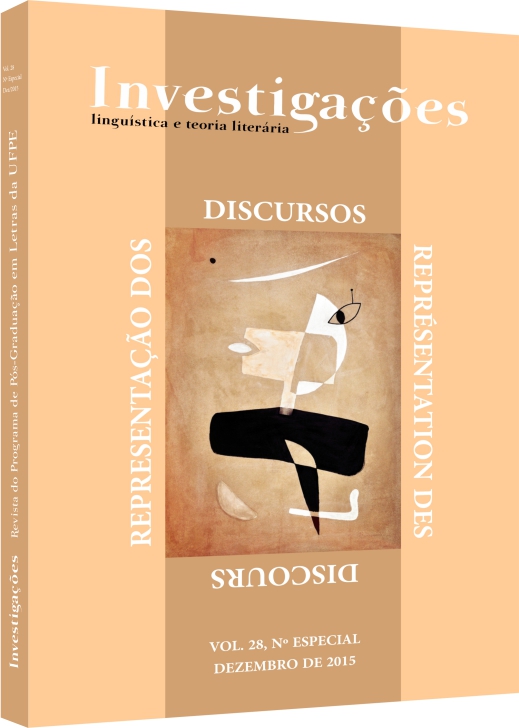Representação do discurso outro e construção de ponto de vista em reportagens e artigos de opinião
Resumo
Dedicando atenção aos fenômenos de heterogeneidade enunciativa, este artigo analisa comparativamente a construção do ponto de vista em dois gêneros da mídia escrita, reportagem e artigo de opinião, publicados em diferentes veículos da imprensa brasileira sobre o discurso da presidenta Dilma Roussef, realizado na ONU em setembro de 2013. Considerando que estes gêneros concedem grande espaço ao discurso outro, o que pode ser vislumbrado através de procedimentos de apreensão a alteridade, este artigo propõe observar como a representação do discurso outro contribui para a construção do ponto de vista neste dois gêneros.Referências
AMOSSY, RUTH. L’argumentation dans le discours. 2ed. Paris: Armand Colin, 2006.
AUTHIER-REVUZ, Jacqueline. Dire à l’autre dans le déjà-dit : inter¬férences d’altérités – interlocutive et interdiscursive – au cœur du dire. In : C. U. Lorda Mur (éd.). Polifonia e intertextualidad en el dialogo. Madrid : Oralia, Arco Libros, 2012a. p.19-44.
______. Représentation du discours autre et catégorisation métalangagière. In : Grinshpun,Y.& Nyée-Doggen, J.(éds). Regards croisés sur la langue française : usases, pratiques, histoire. Paris : Presses de la Sorbonne Nouvelle, 2012b. p.157-170.
______. La représentation du discours autre : un champ multiplement hétérogène » dans J.-M. Lopez-Munoz, S. Mar¬nette et L. Rosier (éds). Le Discours rapporté dans tous ses états. Paris : L’Harmattan, 2004. p. 35-53.
______. Hétérogénéité(s) énonciatives(s). Cadernos de Estudos Linguísticos, Campinas, 19: 25-42: jul/dez, [1984]1990. Tradução Celene M. Cruz e João Wanderley Geraldi.
CUNHA, Dóris de Arruda Carneiro da. Formes et degrés d’orientation dialogique, genre et point de vue. In: L’Hétérogène à l’oeuvre dans la langue et les discours: Hommage à Jacqueline Authier-Revuz. Limoges : Lambert-Lucas, 2012, v.1, p. 289-302.
______. Circulação, reacentuação e memória no discurso da imprensa. Bakhtiniana, São Paulo, 2009, v. 1, n. 2, p. 23-39.
______. Do discurso citado à circulação dos discursos: a reformulação bakhtiniana de uma noção gramatical. Matraga 22, Rio de Janeiro: Casa Doze, 2008, p. 129-144.
DOQUET-LACOSTE, Claire. O jovem escrevente e seus duplos. Debates em educação. Maceió, Vol. 5, n. 10, Jul./Dez. 2013. Tradução de Roberta Freitas, Eliene Santos e Kall Anne Amorim.
DUCROT, Oswald. Le dire et le dit. Paris: Les Éditions de Minuit, 1984. cap.8, Esquisse d’une théorie polyphonique de l’énonciation , p.171-233.
EMEDIATO, Wander. A construção da opinião na mídia : argumentação e dimensão argumentativa. In : ______ (org.). A construção da opinião na mídia. Belo Horizonte : FALE/UFMG, 2013.
FRANCIS, Gilles. Labelling discourse: an aspecto of nominal-group lexical cohesion. In: COULTHARD, M. (ed.). Advances in written texts analyses. London: Routledge, 1994.
GUADANINI, Sandra Magna. A construção da opinião através da designação nas revistas informativas. In : ______ (org.). A construção da opinião na mídia. Belo Horizonte : FALE/UFMG, 2013.
KOCH, Ingerore Grunfeld Villaça. Sobre a seleção do nome núcleo das formas nominais anafóricas na progressão referencial. In: NEGRI, L.; FOLTRAN, M.J.; PIRES de OLIVEIRA, R. (orgs.). Sentido e significação em torno da obra de Rodolfo Ilari. São Paulo: Contexto, 2004, p.244-262.
RABATEL, Alain. La part de l’énonciateur dans la construction interactionnelle des points de vue. Marges linguistiques 9, 2005, p.115-136.
______ . Homo narrans. Pour une analyse énonciative et interactionnelle du récit. Tome 2. Dialogisme et polyphonie dans le récit. Limoges : Editions Lambert-Lucas, 2008.
ROSIER, Laurence. Le discours rapporté en français. Paris: Ophrys, 2008.
Downloads
Publicado
Como Citar
Edição
Seção
Licença
Copyright (c) 2015 Suzana Leite Cortez

Este trabalho está licenciado sob uma licença Creative Commons Attribution 4.0 International License.
Autores que publicam na Revista Investigações concordam com os seguintes termos:
Autores mantêm os direitos autorais e concedem à revista o direito de primeira publicação, com o trabalho simultaneamente licenciado sob a licença Creative Commons Atribuição 4.0 Internacional (CC BY 4.0) que permite o compartilhamento do trabalho com reconhecimento da autoria e publicação inicial nesta revista.
Autores têm autorização para assumir contratos adicionais separadamente, para distribuição não-exclusiva da versão do trabalho publicada nesta revista (exemplo: depositar em repositório institucional ou publicar como capítulo de livro), com reconhecimento de autoria e publicação inicial nesta revista.
Qualquer usuário tem direito de:
Compartilhar — copiar e redistribuir o material em qualquer suporte ou formato para qualquer fim, mesmo que comercial.
Adaptar — remixar, transformar e criar a partir do material para qualquer fim, mesmo que comercial.
O licenciante não pode revogar estes direitos desde que você respeite os termos da licença.
De acordo com os termos seguintes:
Atribuição — Você deve dar o crédito apropriado, prover um link para a licença e indicar se mudanças foram feitas. Você deve fazê-lo em qualquer circunstância razoável, mas de nenhuma maneira que sugira que o licenciante apoia você ou o seu uso.
Sem restrições adicionais — Você não pode aplicar termos jurídicos ou medidas de caráter tecnológico que restrinjam legalmente outros de fazerem algo que a licença permita.

